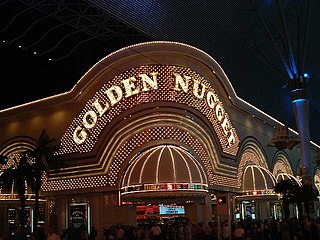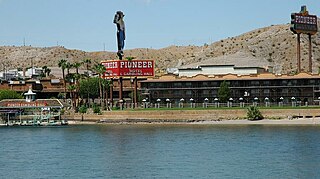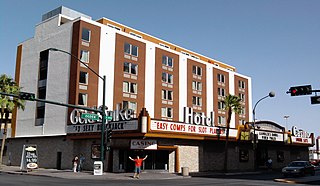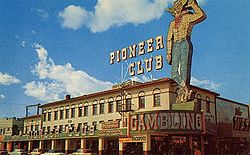
Las Vegas, often known simply as Vegas, is the most populous city in the U.S. state of Nevada and the county seat of Clark County. The Las Vegas Valley metropolitan area is the largest within the greater Mojave Desert, and second-largest in the Southwestern United States. Las Vegas is an internationally renowned major resort city, known primarily for its gambling, shopping, fine dining, entertainment, and nightlife, with most venues centered on downtown Las Vegas and more to the Las Vegas Strip just outside city limits. The Las Vegas Valley as a whole serves as the leading financial, commercial, and cultural center for Nevada. According to the United States Census Bureau, the city had 641,903 residents in 2020, with a metropolitan population of 2,227,053, making it the 25th-most populous city in the United States.

The Golden Nugget Las Vegas is a luxury hotel and casino located in downtown Las Vegas, Nevada on the Fremont Street Experience. The property is owned and operated by Landry's, Inc. It has 2,419 hotel rooms.

The Fremont Hotel & Casino is located in downtown Las Vegas, Nevada. It is part of the Fremont Street Experience, named after American explorer and politician John C. Frémont. The casino is operated by the Boyd Gaming Corporation.

The Fremont Street Experience (FSE) is a pedestrian mall and attraction in downtown Las Vegas, Nevada. The FSE occupies the westernmost five blocks of Fremont Street, including the area known for years as "Glitter Gulch", and portions of some other adjacent streets.
Las Vegas Boulevard is a major road in Clark County, Nevada, United States, best known for the Las Vegas Strip portion of the road and its casinos. Formerly carrying U.S. Route 91 (US 91), which had been the main highway between Los Angeles, California and Salt Lake City, Utah, it has been bypassed by Interstate 15 and serves mainly local traffic with some sections designated State Route 604.

Downtown Las Vegas is the central business district and historic center of Las Vegas, Nevada, United States. It is the original townsite, and the Downtown gaming area was the primary gambling district of Las Vegas prior to the Strip. As the urban core of the Las Vegas Valley, it features a variety of hotel and business highrises, cultural centers, historical buildings and government institutions, as well as residential and retail developments. Downtown is located in the center of the Las Vegas Valley and just north of the Las Vegas Strip, centered on Fremont Street, the Fremont Street Experience and Fremont East. The city defines the area as bounded by I-15 on the west, Washington Avenue on the north, Maryland Parkway on the east and Sahara Avenue on the south.

The Golden Gate Hotel & Casino is located at One Fremont Street in Las Vegas, Nevada, United States. A part of the Fremont Street Experience, it is the oldest and smallest hotel on the Fremont Street Experience.

Fremont Street is a street in downtown Las Vegas, Nevada that is the second most famous street in the Las Vegas Valley – and Nevada – besides the Las Vegas Strip. Named in honor of explorer and politician, and coordinator of the Sacramento River massacre John C. Frémont and located in the heart of the downtown casino corridor, Fremont Street is today, or was, the address for many famous casinos such as Binion's Horseshoe, Eldorado Club, Fremont Hotel and Casino, Golden Gate Hotel and Casino, Golden Nugget, Four Queens, The Mint, and the Pioneer Club.

Binion's Gambling Hall & Hotel, formerly Binion's Horseshoe, is a casino on Fremont Street along the Fremont Street Experience mall in Downtown Las Vegas, Nevada, United States. It is owned by TLC Casino Enterprises. The casino is named for its founder, Benny Binion, whose family ran it from its founding in 1951 until 2004. The hotel, which had 366 rooms, closed in 2009. TLC reopened 81 of the rooms as a boutique hotel called Hotel Apache in July 2019.

Vegas Vic is a neon sign portraying a cowboy which was erected on the exterior of The Pioneer Club in Las Vegas, Nevada, USA in 1951. The sign was a departure in graphic design from typeface based neon signs, to the friendly and welcoming human form of a cowboy. The sign's human-like abilities of talking and waving its arm received an immediate acceptance as the unofficial welcoming sign, reproduced thousands of times over the years and all over the world. The sign can still be found at 25 E Fremont Street, where it has been since 1951 on the exterior of what used to be The Pioneer Club but is currently a souvenir shop. The trademark is currently owned by Pioneer Hotel, Inc., which owns and operates the Pioneer Hotel and Gambling Hall on the Colorado River in Laughlin, Nevada. Laughlin has a twin of the Vegas Vic image on another large sign referred to as River Rick.

El Cortez, a hotel and casino, is a relatively small downtown Las Vegas gaming venue a block from the Fremont Street Experience and Las Vegas Boulevard. Slots, table games, and a race and sports book occupy one floor of the main pavilion, at this historic casino. It opened on Fremont Street on November 7, 1941, and is one of the oldest casino-hotel properties in Las Vegas, along with the nearby Golden Gate Hotel and Casino. Primarily Spanish Colonial Revival in style, it reflects a 1952 remodel when the façade was modernized. On February 22, 2013, the structure was placed on the National Register of Historic Places.

YESCO is a privately owned manufacturer of electric signs based in Salt Lake City, founded by Thomas Young in 1920. The company provides design, fabrication, installation and maintenance of signs.

Las Vegas Club was a hotel and casino located on the Fremont Street Experience in downtown Las Vegas, Nevada. The Las Vegas Club opened in 1930, joining the Las Vegas Hotel which had opened in 1908. The Las Vegas Club was relocated across the street in 1949. At its new location, the Las Vegas Club operated within the Overland Hotel, which was established in 1905.

Pioneer Hotel & Gambling Hall is a hotel and casino located on the banks of the Colorado River in Laughlin, Nevada. It is known for its neon cigarette-puffing "River Rick" marque. It was a sister property of the Pioneer Club in Las Vegas until both properties were sold to separate parties.

Gold Spike is a bar, lounge, residential building, and former boutique 112-room, seven floor hotel. It is connected with the Oasis at the Gold Spike, a 50-room three floor hotel located in downtown Las Vegas. It was owned by entrepreneur Tony Hsieh and his Downtown Project, having bought it from The Siegel Group; and the casino was operated by Golden Gaming.

The D Las Vegas Casino Hotel is a 34-story, 639-room hotel and casino in downtown Las Vegas, Nevada, owned and operated by Derek and Greg Stevens.

La Bayou was a casino located on the Fremont Street Experience in Downtown Las Vegas, Nevada.

The 1950s was a time of considerable change for Las Vegas. By the 1950s, there were 44,600 living in the Las Vegas Valley. Over 8 million people were visiting Las Vegas annually in 1954, pumping $200 million into casinos, which consolidated its image as "wild, full of late-night, exotic entertainment". The population grew dramatically from 8,422 during World War II to over 45,000. From 1952 to 1957, through money and institutional lending provided by the Teamsters Union and some Mormon bankers, they built the Sahara, the Sands, the New Frontier, the Royal Nevada, the Showboat, the Riviera, the Fremont, Binion's Horseshoe, and finally the Tropicana. Gambling was no longer the only attraction by the 1950s; the biggest stars of films and music like Frank Sinatra, Dean Martin, Sammy Davis, Jr., Peter Lawford, Andy Williams, Liberace, Bing Crosby, Carol Channing, and others performed in intimate settings and brought a whole new brigade of Hollywood film stars and others in the entertainment business to the city. In 1957, the first topless show "Minsky's Follies" was started here.

Las Vegas in the 1940s was notable for the establishment of The Strip in a town which "combined Wild West frontier friendliness with glamor and excitement". In 1940, the population was 8,400 but within five years, it more than doubled its size. The Las Vegas Valley had a population of 13,937 in 1940, increasing to 35,000 in just two years.

Circa Resort & Casino is a casino and hotel resort in downtown Las Vegas, Nevada, on the Fremont Street Experience. The property was previously occupied by the Las Vegas Club hotel-casino, the Mermaids Casino, and the Glitter Gulch strip club. Circa is owned by brothers Derek and Greg Stevens, who also own other downtown casinos. They purchased the Las Vegas Club in 2015, followed by the acquisition of Mermaids and Glitter Gulch. The three businesses were demolished in 2017, and construction on Circa began in February 2019, with an opening initially scheduled for December 2020.

























